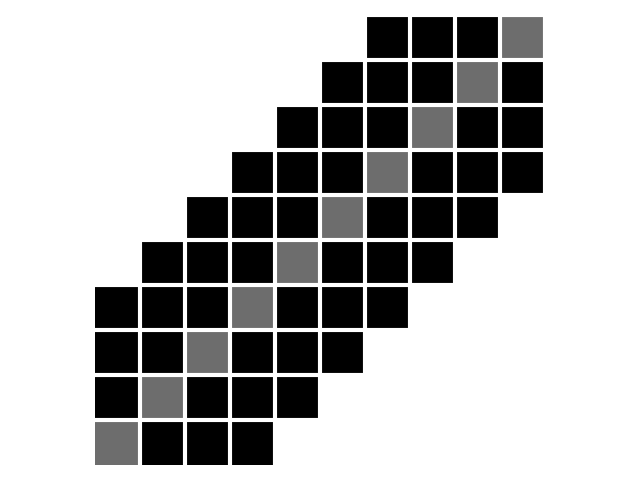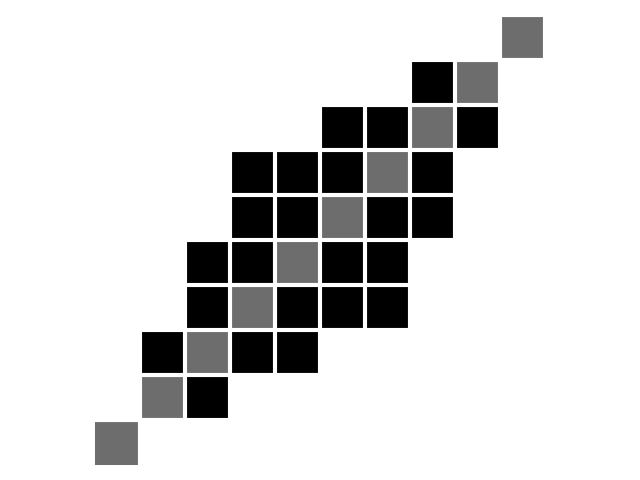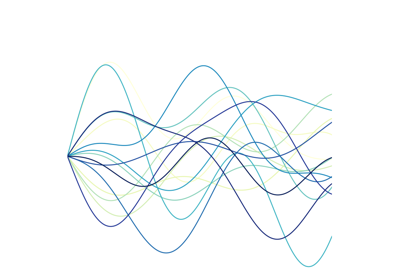Longest Common Subsequence¶
Longest Common Subsequence (LCSS) [1] is a similarity measure between time series.
Let us consider two time series \(x = (x_0, \dots, x_{n-1})\) and
\(y = (y_0, \dots, y_{m-1})\) of respective lengths \(n\) and
\(m\).
Here, all elements \(x_i\) and \(y_j\) are assumed to lie in the same
\(d\)-dimensional space.
In tslearn, such time series would be represented as arrays of respective
shapes (n, d) and (m, d) and LCSS can be computed using the following code:
from tslearn.metrics import lcss, lcss_path
lcss_score = lcss(x, y)
# Or, if the path is also an important information:
path, lcss_score = lcss_path(x, y)
This is the algorithm at stake when invoking
tslearn.clustering.TimeSeriesKMeans with
metric="lcss".
Problem¶
The similarity S between \(x\) and \(y\), given an integer :math epsilon and a real number :math delta, is formulated as follows:
The constant \(\delta\) controls how far in time we can go in order to match a given point from one time-series to a point in another time-series. The constant \(\epsilon\) is the matching threshold.
Here, a path can be seen as the parts of the time series where the Euclidean distance between them does not exceed a given threshold, i.e., they are close/similar.
Algorithmic solution¶
There exists an \(O(n^2)\) algorithm to compute the solution for this problem (pseudo-code is provided for time series indexed from 1 for simplicity):
def lcss(x, y):
# Initialization
for i = 0..n
C[i, 0] = 0
for j = 0..m
C[0, j] = 0
# Main loop
for i = 1..n
for j = 1..m
if dist(x_i, x_j) <= epsilon and abs(j - i) <= delta:
C[i, j] = C[i-1, j-1] + 1
else:
C[i, j] = max(C[i, j-1], C[i-1, j])
return C[n, m]
Using a different ground metric¶
By default, tslearn uses squared Euclidean distance as the base metric
(i.e. \(dist()\) in the problem above is the
Euclidean distance). If one wants to use another ground metric, the code
would then be:
from tslearn.metrics import lcss_path_from_metric
path, cost = lcss_path_from_metric(x, y, metric=compatible_metric)
Properties¶
The Longest Common Subsequence holds the following properties:
\(\forall x, y, LCSS(x, y) \geq 0\)
\(\forall x, y, LCSS(x, y) = LCSS(y, x)\)
\(\forall x, LCSS(x, x) = 0\)
However, mathematically speaking, LCSS is not a valid measure since it does not satisfy the triangular inequality.
Additional constraints¶
One can set additional constraints to the set of acceptable paths. These constraints typically consists in forcing paths to lie close to the diagonal.
First, the Sakoe-Chiba band is parametrized by a radius \(r\) (number of off-diagonal elements to consider, also called warping window size sometimes), as illustrated below:

\(n = m = 10, r = 3\). Diagonal is marked in grey for better readability.¶
The corresponding code would be:
from tslearn.metrics import lcss
cost = lcss(x, y, global_constraint="sakoe_chiba", sakoe_chiba_radius=3)
Second, the Itakura parallelogram sets a maximum slope \(s\) for alignment paths, which leads to a parallelogram-shaped constraint:

\(n = m = 10, s = 2\). Diagonal is marked in grey for better readability.¶
The corresponding code would be:
from tslearn.metrics import lcss
cost = lcss(x, y, global_constraint="itakura", itakura_max_slope=2.)
Examples Involving LCSS variants¶

Longest Commom Subsequence with a custom distance metric